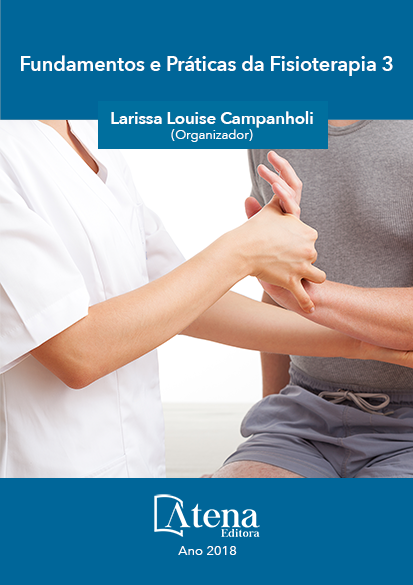
EFEITO CRÔNICO DA ESTIMULAÇÃO TRANCRANIANA POR CORRENTE CONTÍNUA, COMBINADA AO TREINAMENTO FÍSICO, SOBRE O DESEMPENHO NEUROMUSCULAR E CARDIOPULMONAR EM PACIENTES DE AVC
Sobreviventes ao acidente vascular
cerebral (AVC) frequentemente manifestam
sequelas no controle motor. Programas de
treinamento físico e terapias neurológicas
objetivando estimular a plasticidade cerebral
são essenciais para a reabilitação desses
pacientes. A Estimulação Transcraniana por
Corrente Contínua (ETCC) pode auxiliar na
reabilitação motora pós-AVC, mas seu efeito
combinado a programas de condicionamento
físico de longo prazo ainda não foi testado
experimentalmente. Portanto, o objetivo do
presente trabalho foi investigar o efeito isolado e
combinado de 12 sessões de treinamento físico
e ETCC sobre a função motora, força muscular
e capacidade cardiopulmonar de pacientes
com sequela motora por AVC. Participaram do
estudo 15 pacientes (4 mulheres; 55 ±10 anos;
IMC 26,4±5 kg/m2; 22±10 meses pós-AVC).
A amostra foi dividida em 2 grupos, ETCC
(experimental) e SHAM (controle) de forma
randomizada. Antes de cada sessão, aplicavase
a ETCC por 20 min com intensidade de
2mA. A rotina de treinamento consistiu em 20
min de exercício aeróbio, exercícios de função
manual, exercícios resistidos e alongamentos.
Como resultados, ambos os grupos exibiram
melhorias na função motora, após intervenção.
Contudo, somente o grupo ETCC apresentou
melhora da força muscular (28,9±26,9%
ETCC vs. 5,9±14,1% SHAM P=0,05) e VO2máx
(13,5±17,7% ETCC vs. -10±15,1 SHAM;
P=0,04). Concluiu-se que, pacientes com sequela motora pós-AVC, submetidos à
ETCC combinada a treinamento físico multimodal, exibiram maiores ganhos na função
motora, força muscular e VO2máx do que aqueles que realizaram treinamento físico
isolado.
EFEITO CRÔNICO DA ESTIMULAÇÃO TRANCRANIANA POR CORRENTE CONTÍNUA, COMBINADA AO TREINAMENTO FÍSICO, SOBRE O DESEMPENHO NEUROMUSCULAR E CARDIOPULMONAR EM PACIENTES DE AVC
-
DOI: atena
-
Palavras-chave: Acidente Vascular Cerebral, Reabilitação Motora, Neuromodulação, Neuroplasticidade, Capacidade Física
-
Keywords: Stroke, Motor Recovery, Neuromodulation, Neuroplasticity, Physical Capacity.
-
Abstract:
Stroke survivors often manifest motor impairments. Physical exercise
programs and neurological therapies to stimulate brain plasticity are essential for the
rehabilitation of these patients. Seems that Transcranial Direct Current Stimulation
(tDCS) can helps post-stroke motor recovery, but it has not yet been experimentally
tested the combined effect with long-term physical conditioning programs. Therefore,
the aim of the present study was to investigate the isolated and combined effect of
12 sessions of physical training and tDCS on motor function, muscle strength and
cardiopulmonary capacity of stroke patients. Fifteen patients (4 women, 55 ± 10 years,
BMI 26.4 ± 5 kg / m2, 22 ± 10 months post-stroke) participated in the study. The sample
was divided into 2 groups, tDCS (experimental) and SHAM (control) in a randomized
fashion. The tDCS was applied for 20 min with intensity of 2mA before each session.
The training routine consisted in 20 min of aerobic exercise, manual function exercises,
strength exercises and stretching. As a result, both groups showed improvements in
motor function after intervention. However, only the ETCC group showed improvement
of muscle strength (28.9 ± 26.9% tDCS vs. 5.9 ± 14.1% SHAM P = 0.05), and VO2max
(13.5 ± 17.7% CTEF vs. -10 ± 15.1 SHAM, P = 0.04) were higher in tDCS group than
SHAM. It was concluded that, patients with motor sequelae after stroke, submitted
to tDCS combined with multimodal physical exercise training induced improvements
in motor function, muscle strength and VO2max than those who performed isolated
physical exercise program.
-
Número de páginas: 15
- Paulo Farinatti
- Wendell Leite Bernardes
- Felipe Amorim da Cunha
- Rafael Ayres Montenegro
- Renato Massaferri


